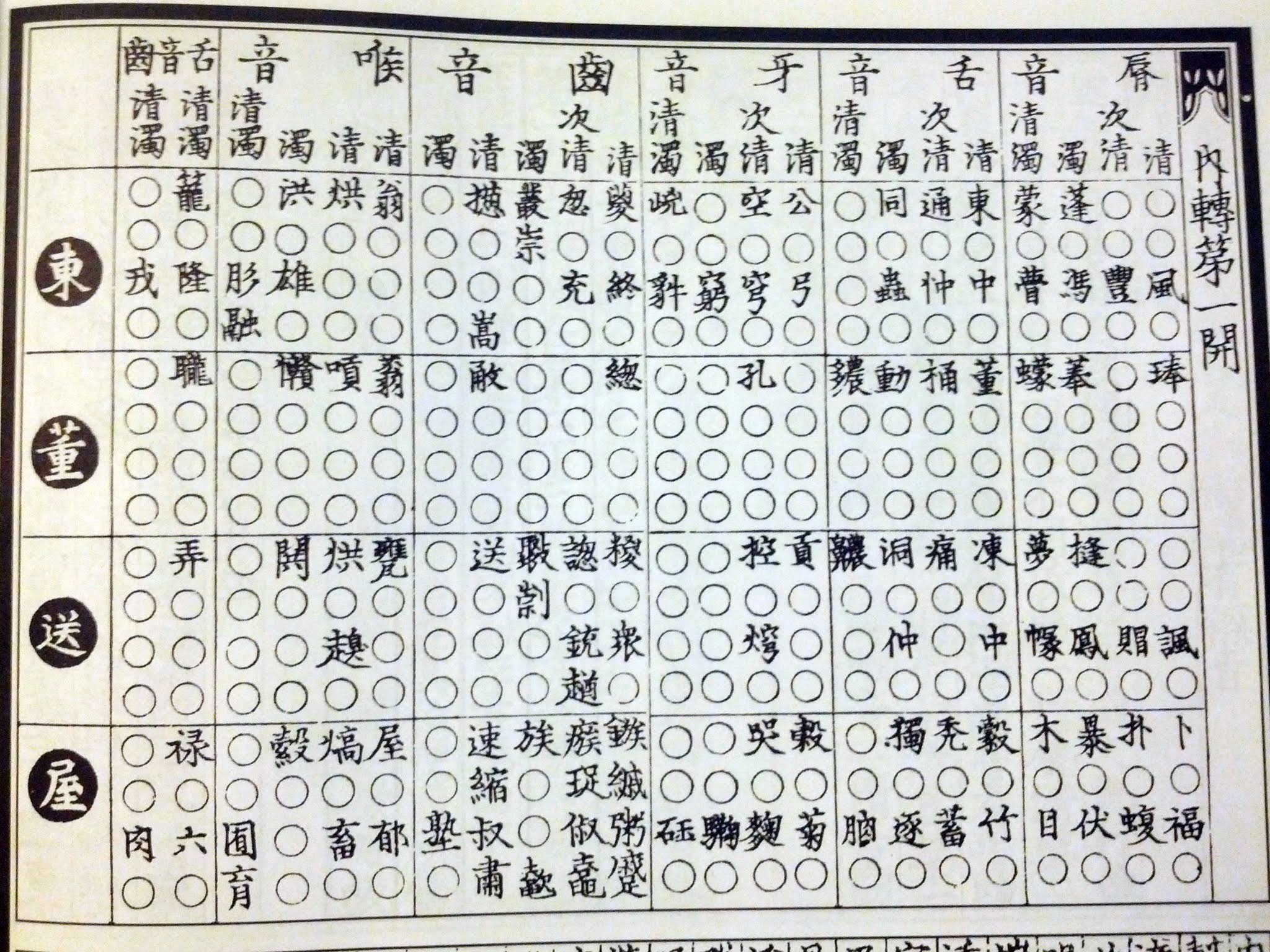|
Qiyin Lüe
The ''Qiyin lüe'' () is a Chinese rime table, which dates to before 1161. This reference work survived to the present largely because the Song dynasty historian Zheng Qiao (/; ''Cheng Ch'iao''; 1104–1162) included it in his 1161 encyclopedia '' Tongzhi''. The Chinese linguist Luo Changpei wrote a definitive study (1935) of the ''Qiyin lüe''. The structure and contents of the work is closely related to the ''Yunjing'', and the two are believed to derive from a common source prior to the Song dynasty. Both have tables combining rows for a particular final rime, columns for various initials, and up to four tones. See also * Rime dictionary References External links parts 34–36an37–38of the ''Tongzhi'' encyclopedia at the Internet Archive The Internet Archive is an American digital library with the stated mission of "universal access to all knowledge". It provides free public access to collections of digitized materials, including websites, software applications/ga ... [...More Info...] [...Related Items...] OR: [Wikipedia] [Google] [Baidu] |
Chinese Language
Chinese (, especially when referring to written Chinese) is a group of languages spoken natively by the ethnic Han Chinese majority and many minority ethnic groups in Greater China. About 1.3 billion people (or approximately 16% of the world's population) speak a variety of Chinese as their first language. Chinese languages form the Sinitic branch of the Sino-Tibetan languages family. The spoken varieties of Chinese are usually considered by native speakers to be variants of a single language. However, their lack of mutual intelligibility means they are sometimes considered separate languages in a family. Investigation of the historical relationships among the varieties of Chinese is ongoing. Currently, most classifications posit 7 to 13 main regional groups based on phonetic developments from Middle Chinese, of which the most spoken by far is Mandarin (with about 800 million speakers, or 66%), followed by Min (75 million, e.g. Southern Min), Wu (74 million, e.g. Shangh ... [...More Info...] [...Related Items...] OR: [Wikipedia] [Google] [Baidu] |
Rime Table
A rime table or rhyme table () is a Chinese phonological model, tabulating the syllables of the series of rime dictionaries beginning with the ''Qieyun'' (601) by their onsets, rhyme groups, tones and other properties. The method gave a significantly more precise and systematic account of the sounds of those dictionaries than the previously used analysis, but many of its details remain obscure. The phonological system that is implicit in the rime dictionaries and analysed in the rime tables is known as Middle Chinese, and is the traditional starting point for efforts to recover the sounds of early forms of Chinese. Some authors distinguish the two layers as Early and Late Middle Chinese respectively. The earliest rime tables are associated with Chinese Buddhist monks, who are believed to have been inspired by the Sanskrit syllable charts in the Siddham script they used to study the language. The oldest extant rime tables are the 12th-century ''Yunjing'' ("mirror of rhymes") an ... [...More Info...] [...Related Items...] OR: [Wikipedia] [Google] [Baidu] |
Song Dynasty
The Song dynasty (; ; 960–1279) was an imperial dynasty of China that began in 960 and lasted until 1279. The dynasty was founded by Emperor Taizu of Song following his usurpation of the throne of the Later Zhou. The Song conquered the rest of the Ten Kingdoms, ending the Five Dynasties and Ten Kingdoms period. The Song often came into conflict with the contemporaneous Liao, Western Xia and Jin dynasties in northern China. After retreating to southern China, the Song was eventually conquered by the Mongol-led Yuan dynasty. The dynasty is divided into two periods: Northern Song and Southern Song. During the Northern Song (; 960–1127), the capital was in the northern city of Bianjing (now Kaifeng) and the dynasty controlled most of what is now Eastern China. The Southern Song (; 1127–1279) refers to the period after the Song lost control of its northern half to the Jurchen-led Jin dynasty in the Jin–Song Wars. At that time, the Song court retreated south of the ... [...More Info...] [...Related Items...] OR: [Wikipedia] [Google] [Baidu] |
Tongzhi (encyclopedia)
''Tongzhi'' ("Comprehensive Records") is an 1161 Chinese general knowledge encyclopedia written by Zheng Qiao (鄭樵) in the Song dynasty, containing 200 chapters on diverse topics. Contents After the ''Tongdian'', it was the second encyclopedia of the ''Santong'' (The Three Encyclopedias), which were often published together. It is also included second among the ''Shitong'' (The Ten Encyclopedias), compiled in the Qing dynasty. The ''Tongzhi'' became a model for most of the later encyclopedias. ''Tongzhi'' is arranged in 200 volumes (''juan''), plus three volumes of notes. The historical information covers from earliest times to the end of the Tang dynasty. The contents include basic annals, yearly chronicles, hereditary houses, ranked biographies, and twenty monographs (''lüe'' 略) on various topics, the last of which are considered the most original part.Endymion, 526. The twenty monographs, which comprise 52 volumes, deal with clans, the six classes of characters, phoneti ... [...More Info...] [...Related Items...] OR: [Wikipedia] [Google] [Baidu] |
Luo Changpei
Luo Changpei (; 9 August 1899 – 13 December 1958) was a Chinese linguist. He made important contributions to the study of historical Chinese phonology. He was also a pioneer of the modern studies of Chinese dialects and of non-Chinese languages in China. Born into a Manchu people, Manchu family, he graduated from the Peking University. Besides spending some years in the United States as a visiting scholar, he spent most of his academic life at Peking University. Among his students there were the British scholars Michael Halliday and David Hawkes (sinologist), David Hawkes. In 1929, along with Y.R. Chao and Li Fang-kuei, he became a researcher at the Institute of History and Philology (歷史語言研究所) of Academia Sinica (then located at Nanjing). He also served as director of the Institute of Linguistics at the Chinese Academy of Sciences until his death in 1958. Luo also co-authored a book on the 'Phags-pa script with Cai Meibiao (). Bibliography With Zhou Zumo () * ... [...More Info...] [...Related Items...] OR: [Wikipedia] [Google] [Baidu] |
Yunjing
The ''Yunjing'' () is one of the two oldest existing examples of a Chinese rhyme table – a series of charts which arrange Chinese characters in large tables according to their tone and syllable structures to indicate their proper pronunciations. Current versions of the ''Yunjing'' date to AD 1161 and 1203 editions published by Zhang Linzhi (張麟之). The original author(s) and date of composition of the ''Yunjing'' are unknown. Some of its elements, such as certain choices in its ordering, reflect features particular to the Tang dynasty, but no conclusive proof of an actual date of composition has yet been found. The ''Yunjing'' contains 43 tables (), each of which tabulates combinations of a particular final rhyme (listed in rows) with various initials (listed in columns), in up to four tones, to show in a grid pattern all possible syllables. Empty circles on the grid denote that the author(s) were unaware of any word with that particular pronunciation. By locating a char ... [...More Info...] [...Related Items...] OR: [Wikipedia] [Google] [Baidu] |
Tone (linguistics)
Tone is the use of pitch in language to distinguish lexical or grammatical meaning – that is, to distinguish or to inflect words. All verbal languages use pitch to express emotional and other paralinguistic information and to convey emphasis, contrast and other such features in what is called intonation (linguistics), intonation, but not all languages use tones to distinguish words or their inflections, analogously to consonants and vowels. Languages that have this feature are called tonal languages; the distinctive tone patterns of such a language are sometimes called tonemes, by analogy with ''phoneme''. Tonal languages are common in East and Southeast Asia, Africa, the Americas and the Pacific. Tonal languages are different from Pitch-accent language, pitch-accent languages in that tonal languages can have each syllable with an independent tone whilst pitch-accent languages may have one syllable in a word or morpheme that is more prominent than the others. Mechanics Mo ... [...More Info...] [...Related Items...] OR: [Wikipedia] [Google] [Baidu] |
Rime Dictionary
A rime dictionary, rhyme dictionary, or rime book () is an ancient type of Chinese dictionary that collates Chinese character, characters by tone (linguistics), tone and rhyme, instead of by radical (Chinese character), radical. The most important rime dictionary tradition began with the ''Qieyun'' (601), which codified correct pronunciations for reading the classics and writing poetry by combining the reading traditions of north and south China. This work became very popular during the Tang dynasty, and went through a series of revisions and expansions, of which the most famous is the ''Guangyun'' (1007–1008). These dictionaries specify the pronunciations of characters using the ''fanqie, fǎnqiè'' method, giving a pair of characters indicating the syllable onset, onset and remainder of the syllable respectively. The later rime tables gave a significantly more precise and systematic account of the sounds of these dictionaries by tabulating syllables by their onsets, rhyme g ... [...More Info...] [...Related Items...] OR: [Wikipedia] [Google] [Baidu] |
Internet Archive
The Internet Archive is an American digital library with the stated mission of "universal access to all knowledge". It provides free public access to collections of digitized materials, including websites, software applications/games, music, movies/videos, moving images, and millions of books. In addition to its archiving function, the Archive is an activist organization, advocating a free and open Internet. , the Internet Archive holds over 35 million books and texts, 8.5 million movies, videos and TV shows, 894 thousand software programs, 14 million audio files, 4.4 million images, 2.4 million TV clips, 241 thousand concerts, and over 734 billion web pages in the Wayback Machine. The Internet Archive allows the public to upload and download digital material to its data cluster, but the bulk of its data is collected automatically by its web crawlers, which work to preserve as much of the public web as possible. Its web archiving, web archive, the Wayback Machine, contains hu ... [...More Info...] [...Related Items...] OR: [Wikipedia] [Google] [Baidu] |
Chinese Dictionaries
Chinese dictionaries date back over two millennia to the Han dynasty, which is a significantly longer lexicographical history than any other language. There are hundreds of dictionaries for the Chinese language, and this article discusses some of the most important. Terminology The general term ''císhū'' (, "lexicographic books") semantically encompasses "dictionary; lexicon; encyclopedia; glossary". The Chinese language has two words for dictionary: ''zidian'' (character/logograph dictionary) for written forms, that is, Chinese characters, and ''cidian'' (word/phrase dictionary), for spoken forms. For character dictionaries, ''zidian'' () combines ''zi'' "character, graph; letter, script, writing; word") and ''dian'' "dictionary, encyclopedia; standard, rule; statute, canon; classical allusion"). For word dictionaries, ''cidian'' is interchangeably written /; ''cídiǎn''; ''tzʻŭ²-tien³''; "word dictionary") or (/; ''cídiǎn''; ''tzʻŭ²-tien³''; "word dictionary"); ... [...More Info...] [...Related Items...] OR: [Wikipedia] [Google] [Baidu] |
Song Dynasty Literature
A song is a musical composition intended to be performed by the human voice. This is often done at distinct and fixed pitches (melodies) using patterns of sound and silence. Songs contain various forms, such as those including the repetition and variation of sections. Written words created specifically for music, or for which music is specifically created, are called lyrics. If a pre-existing poem is set to composed music in classical music it is an art song. Songs that are sung on repeated pitches without distinct contours and patterns that rise and fall are called chants. Songs composed in a simple style that are learned informally "by ear" are often referred to as folk songs. Songs that are composed for professional singers who sell their recordings or live shows to the mass market are called popular songs. These songs, which have broad appeal, are often composed by professional songwriters, composers, and lyricists. Art songs are composed by trained classical composers ... [...More Info...] [...Related Items...] OR: [Wikipedia] [Google] [Baidu] |






